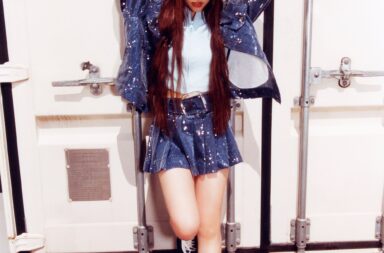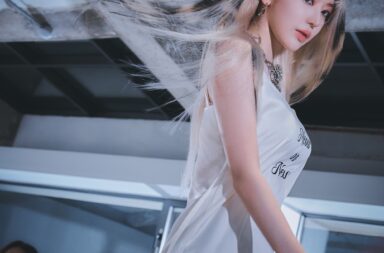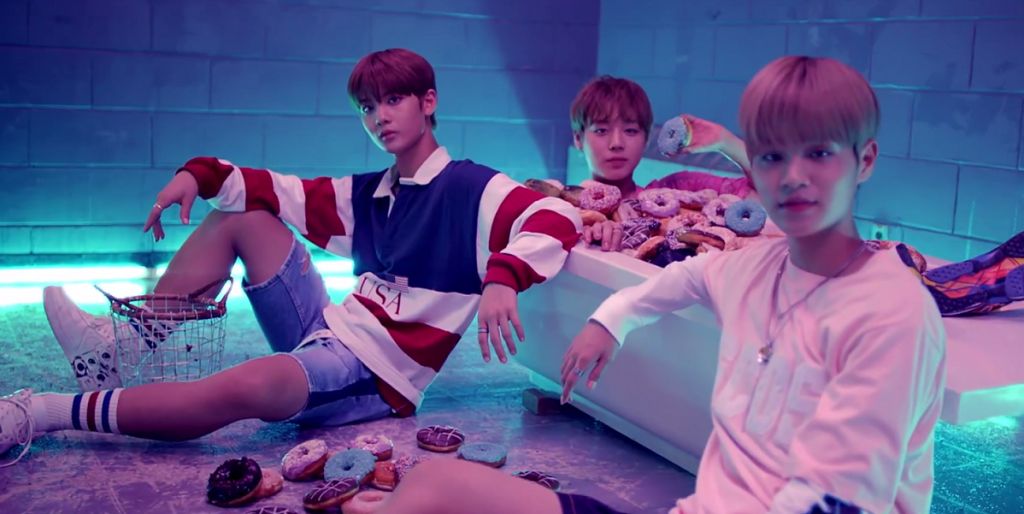
You might have noticed a common, albeit peculiar, trope in many K-pop MVs: the presence of a bathtub. They come in various sizes, shapes, and fillings, and rarely go unnoticed. You might have even asked yourself why such an object is a recurring choice in the most varied contexts a music video can have. Question no more, for here’s an attempt at unveiling the submerged meanings behind this aesthetic vessel.
Due to its primary use as a personal hygiene object, the bathtub is a place of intimacy. As Erving Goffman (1963, p. 40) once said about bathrooms in general:
“[They] are perhaps the main shielding places in Anglo-American society because in many households these are the only rooms in which the solitary person can properly lock himself. And it may be only under these guaranteed conditions that some individuals will feel safe in manifesting certain situationally improper involvements.”
Note that Goffman is talking about Anglo-American society, but this statement remains relevant when discussing K-pop, seeing how the industry continues to be influenced by the United States in general. As for the “situationally improper involvements” he mentions, two instantly take the spotlight when MVs come to mind: sexiness and depression. These are instances where people tend to withdraw from the world so they can be free from the judging eyes of society. With that in mind, the privacy of a bathtub makes for a perfect environment.
However, other involvements might also play part in the K-pop universe. Namely, they can represent a transformational process, where bathing represents a ritual to cleanse the old and start the new, or a take on the absurd, where bathtubs accommodate unexpected contents that exaggerate a motif or bring comical relief.
To better explain these four categories, the following paragraphs attempt to analyse their presence in the actual narratives of selected MVs.
Sexiness
The most common usage of a bathtub in K-pop is to express the idea of sexy, usually allied to the stereotype of how a woman should look and behave. In EXID’s “L.I.E”, for example, LE sits inside one that is full of rubber ducks. While the camera zooms in and out suggestively over her body, she raps about abandoning a lying lover. As the whole MV is filled with sexual innuendos, this particular shot isn’t hard to interpret—the bathtub works as a prop to display her figure and invite lustful thoughts. An interesting information, though, is that “rubber duck” can be a slang for masturbation, adding yet another clever meaning to the narrative. Paired with LE’s confident attitude, it is as though she is deliberately playing a game of seduction with the viewer rather than being objectified against her will.
Another use of the bathtub as a sexy prop, but this time without underlying messages, can be found in TVXQ‘s “Wrong Number”. This is one of the only K-pop MVs to feature a sexy male bathtub scene—perhaps because it was from 2009, when things were a lot different. In this video, TVXQ members get ready to go out and abandon a stalker lover who keeps them under watch on CCTV. Among other romantic cliches like fancy cars and glasses of wine, Yunho was the chosen member to be featured in a revealing bathing scene. One that is only there for the purpose of showcasing his physique.
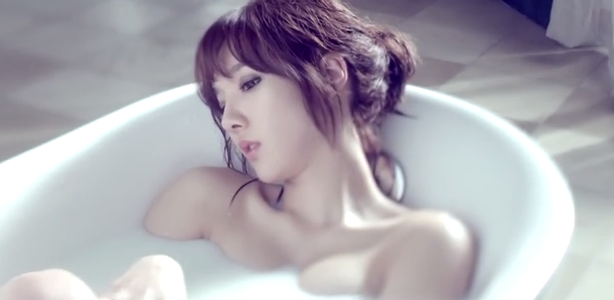
While the previous examples veered more towards sexy performances, Stellar‘s “Marionette” presents a full-on sexual fantasy. The MV is highly suggestive by itself, and the use of the bathtub is just another insinuation among way too many. In it, Minhee sits deep inside a white liquid, clearly used to resemble something else. While she does nothing but to sing and stare blankly, doors appear in frame and add a voyeuristic, predatory mood to the scene. Bathing can surely be a presented healthily as appealing or alluring, but certainly not when the observer breaks intimacy boundaries without previous consent.
Depression
While most MVs featuring sexy bathtub scenes portray a woman, men are favored when it comes to representing depression. It is interesting to notice how this trend might be a reflection of the alarming suicide rates for men in South Korea. BTS’ triad “I Need U”, “Run” and “Lie”, for example, center Jimin’s narrative around a bathtub that serves as an escape from his struggles. First, he tries to drown himself among the angst and nostalgia presented in “I Need U”. Then, in “Run”, he plays with other BTS members in the same bathtub, and one of them even tries to drown him, alluding to a “dream version” of what really happened. Finally, in the short film “Lie”, he falls inside a bathtub again, only to wake up in a hospital bed—the aftermath of his drowning attempt back in “I Need U”, maybe?
Another tragic sample is Monsta X‘s “All In”. In this video, Hyungwon uses the bathtub to take his own life in a dystopian universe. However, the story gets a twist when Minhyuk pours a blue potion into it, jumps inside, and holds Hyungwon’s hand. The homoerotic subtext is hard to ignore and the blue potion, made from hallucinogenic flowers that feature throughout the MV, is revealed to have magical powers. Monsta X is seen running towards a blue, throbbing object at the end of the video, hinting at two possibilities: Minhyuk’s potion either brought Hyungwon back to life, or that they both have joined the other members in some kind of afterlife.
An exception to the gender preference is Brown Eyed Girls‘ “Cleansing Cream”. The moving MV opens up with a scene of a desperate girl inside a bathtub, smeared makeup all over her face. A well-dressed woman is beside her, shocked and crying. As the story goes on, it is implied that the girl is actually the woman’s child-self—a naive kid stumbling into the adult world. After being plagued by memories she wants to forget, the woman finally loses control and throws the girl in the bathtub. This configures a desperate attempt to erase not only the silly makeup, but the girl herself and everything she represents. It is also one of the only MVs that does not portray a sexy image of the female inside its bathtub.
Absurdity
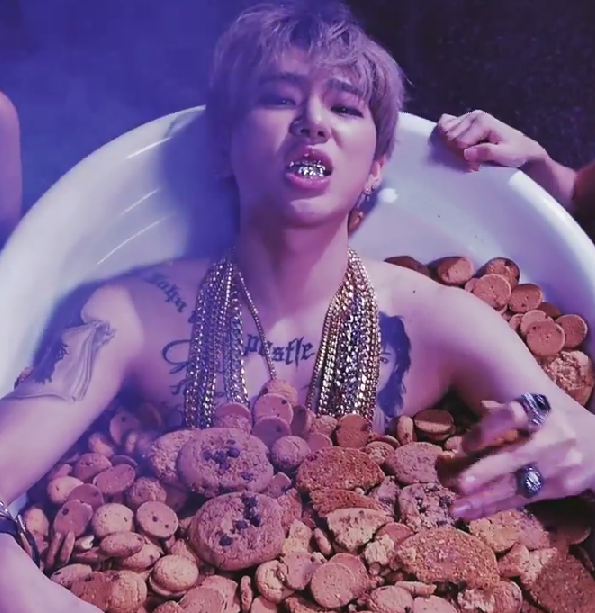
Making use of a bathtub’s container properties to surprise the viewer and catch their attention is also a frequent practice in K-pop. It is impossible to think about Zico‘s solo debut “Tough Cookie” and not remember its cookie-filled bathtub, for example. While the whole video is mostly a bland imitation of American hip-hop stereotypes, this scene is memorable for its literal, unexpected imagery derived from the lyrics. Zico says he’s “a tough cookie, chew me the wrong way and your teeth might go out”—while wearing grills and actually chewing on some, for that matter. By positioning himself in this scenario, he hopes to reaffirm and exaggerate his tough nature, but the final result end up comical, since cookies aren’t exactly the definition of badass. Also, how uncomfortable must all the crumbs feel?
Wanna One’s “Energetic” opts for a softer alternative. Jinyoung and Daehwi cover Jihoon in colorful doughnuts, while playfully eating and even offering a bite to the viewer. It is still an unexpected choice and not the most hygienic endeavour, but the aesthetic effect plays it off. The vivid scene is a nice addition to their narrative of young men having fun and being beautiful. The scene is also another literal representation of what it might mean to feel “energetic”—by getting a sugar rush.
But one of the greatest examples of bathtub absurdity can be found in Matilda’s “Summer Again”. In order to convey the playful and colorful vibe expected from the song’s title, the members engage in typical activities to battle the warm weather, such as going to the beach and having a pool party. However, Haena’s solo scene holds a surprise. She sits fully clothed inside a bathtub of… milk and cereal. While the liquid could have a sexual connotation (like in Stellar’s “Marionette”), in this context it just looks like a really weird way to have fun. It could arguably also be an unusual homage to Matilda—the movie from 1996—and its famous Cheerios scene. Whatever it might be, one question remains: is it a real summer if you haven’t bathed in your breakfast yet?
Transformation
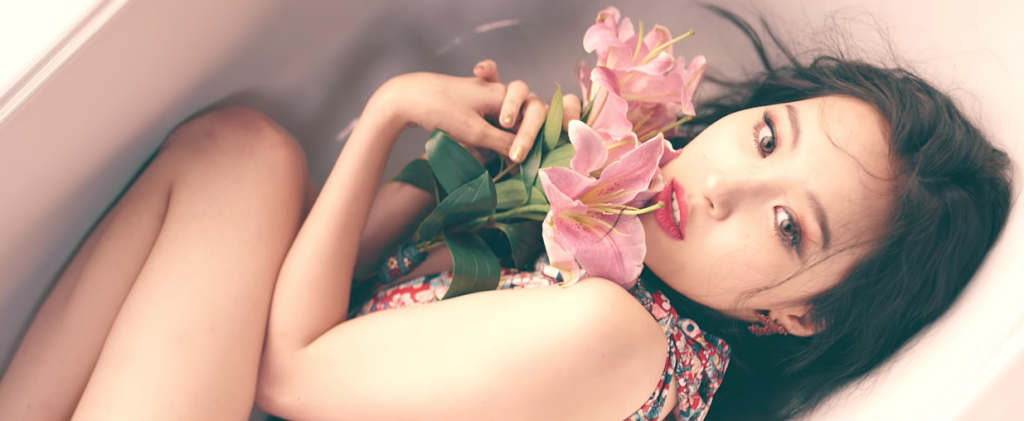
The last category to be analysed sees bathtubs as vehicles for a change. Sunmi’s “Gashina” displays this perfectly, with the object working as a medium through which she recovers from being abandoned. The bathtub travels backwards through all the rooms previously shown as soon as the singer falls into it, in what could represent cleansing and letting go of all the memories. When it arrives in front of her past lover’s car, Sunmi emerges in a glittery dress and fresh-found confidence: she has become a new version of herself, ready to overcome the past.
Another interesting example is Nine Muses‘s “Remember”. Through shots that mix the past with the present, the narrative suggests that the women are suffering and seeking revenge from an abusive relationship. The bathtub makes for an essential part, appearing in almost every scene and serving multiple purposes: a place to hide for Keumjo, a portal to another dimension for Hyemi, and even as a vessel to burn the male character. There are also interesting frames of the quartet inside bathtubs, wet but fully clothed and surrounded by flowers. This imagery hints at the painting Ophelia, by Sir John Everett Millais, therefore making a link with depression and suicidal thoughts that can be triggered during an abusive relationship. Fortunately, the bathtubs in this MV serve as pathways through which the members find strength to overcome the trauma. By killing their past—metaphorically or literally—they are ready to start anew.
On yet another take, f(x)‘s “4 Walls” plays with multiple dimensions where strange things can happen and every act has a consequence. In this MV, the bathtub serves as a portal back to the real world. Krystal falls into a pond, which then becomes Victoria inside a bathtub and Luna getting out of it. Luna goes to sleep after realizing that this will restart their day and prevent the warping of dimensions. Through the element of water and its regenerative powers, they find the connection necessary to heal a distorted reality.
Even though K-pop offers more bathtubs than it would be possible to analyse here, these examples show prevalent trends in the industry. Bathtubs can reveal aspects otherwise hidden, teach important lessons about growth, or lighten up the mood with their quirky fillings, not to mention serving as a prop for depictions of how males and females think and behave. Who knew that a seemingly random object could reveal so much about the ways society works?
(Goffman, Erving. 1963. Behavior in Public Places. New York: The Free Press; YouTube [1][2][3][4][5], lyrics via Color Coded Lyrics, Asia Experts Forum, World Health Organization. Images via Banana Culture Entertainment, YMC Entertainment, SM Entertainment, Stone Music Entertainment, Seven Seasons, AroundUs Entertainment)

